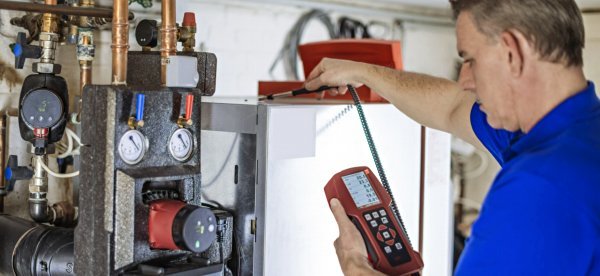The next time the chimney sweep was in the house, the boiler might look a bit more colourful: since the beginning of the year, a number of old devices have been marked with the well-known EU energy label as part of the so-called “Feuerstättenschau”. What has been mandatory for new devices delivered to retailers since the end of September 2015 is now gradually being implemented in existing equipment as well. The label indicates the efficiency class of the heating system and can thus provide the impetus for replacing wasteful boilers. Heaters that are more than 15 years old are marked.
As is usual with labels for electrical appliances, colored bars from green to red show the range of efficiency classes. Next to the specific applicable class there is a marking with a black arrow. The spectrum ranges from A++ (best efficiency) to G (worst energy use) for new devices. For old devices, it goes from A++ to E. For systems that are older than 15 years, however, only the classes from A down will usually be significant, because an efficiency of A+ or A++ can only be achieved with systems that are based on Kraft -Put heat coupling.

Any consequences are initially not associated with the classification. All you have to keep in mind is how efficiently or carelessly your own boiler uses energy. The owner cannot defend himself against the marking, he is also not allowed to remove the label. On the other hand, the labeling does not cost him anything, because the federal government bears the costs for the classification and the labeling.
Since there are far more old heating systems than can be classified in the near future, the chimney sweeps proceed according to the year the system was built. In 2017, it will be the turn of the boilers that were installed up to and including 1991.
consequences of classification
As I said, there is no obligation from the labeling. Nevertheless, it is of course worth thinking about the energy consumption. While the classification into classes A or B still certifies a quite acceptable energy standard – especially for older devices – one should seriously consider upgrading for classes C or worse. At least components, which on the one hand are often responsible for high energy consumption and on the other hand can often be replaced quite easily, could then be replaced. This includes, for example, the circulation pump.
A renewed or optimized heating system in a single-family house can in individual cases save energy costs amounting to several hundred euros. Whether this is the case in each case should be calculated together with a specialist,

for example with an energy consultant. Because one thing is clear: Even if there are interesting funding opportunities for energy-efficient renovation, an investment usually in the four-digit range is initially required for a renovation, and this money must also come in through savings.
Thorough consideration with professional advice is also worthwhile under another aspect: The efficiency label is limited to the boiler and does not take into account the condition of the rest of the heating system, i.e. the distribution and the radiators. And of course the label says nothing about the energetic condition of the building.
Taken by itself, the efficiency label is primarily food for thought and a source of information. But if that actually results in a more thorough look at domestic energy use and a strategy for optimizing where it is now, then it’s a very good idea.
If you want to find out more about the label and its consequences, you can find numerous sources online. These include, for example, the intelligent heating platform operated by the industry association VdZ, as well as the co2online campaign funded by the Federal Ministry for the Environment. [ha]
Photos: © Intelligent heizungen/VdZ, graphics: www.co2online.de
![]()








